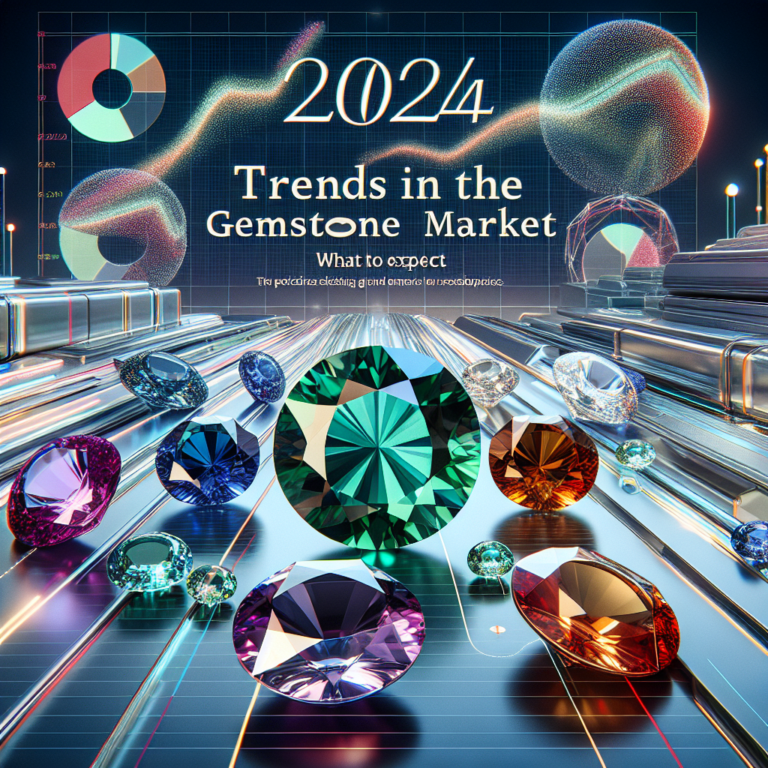2024 Trends in the Gemstone Market: What to Expect
As we usher in 2024, the gemstone market stands at a fascinating intersection of tradition and innovation. Factors such as shifting consumer preferences, advancements in technology, and economic fluctuations are significantly shaping the landscape of the gemstone market. In this article, we’ll discuss the trends to watch for in the coming year, providing insights for both consumers and industry insiders.
The Resurgence of Colored Gemstones
One of the most notable trends in the gemstone market is the increasing popularity of colored gemstones. While diamonds have long held a monopoly on the luxury jewelry sector, the tides are turning. As of 2023, colored gemstones now account for approximately 30% of the market share, a figure that’s expected to rise further in 2024.
Consumer Shift Towards Unique Spaces
Today’s consumers, particularly millennials and Gen Z, are gravitating towards unique and sustainable options. They prioritize individuality and ethical sourcing, which are central to the colored gemstone appeal. For example, stones such as emeralds, sapphires, and rubies provide a vibrant aesthetic alternative to traditional diamonds.
Example: The Rise of Uniquely Sourced Stones
Consider the case of sapphire engagement rings. With an estimated increase of 15% in sales in the past year, sapphires are becoming mainstream. Their unique hues—ranging from deep blue to pink—capture the attention of young couples looking for distinctive symbols of their commitment.
Sustainability Becomes a Central Focus
Another major trend in the gemstone market is the accelerated push for sustainability. As consumers become more environmentally conscious, demand for ethically sourced stones is at an all-time high.
Lab-Created Gemstones on the Rise
Lab-created gemstones are experiencing significant growth, with the market projected to reach $2.5 billion by the end of 2024. These stones are not only more affordable, averaging 20-40% less than their mined counterparts, but they also come without the ethical concerns tied to traditional mining.
Expanded Awareness and Transparency
Many consumers are seeking transparency about the origins of their gemstones. Businesses are increasingly providing this information, using blockchain technology to assure customers of sustainable practices. For instance, brands showcasing lab-created diamonds have begun to include detailed sourcing information, appealing to ethical consumers.
Technological Innovations in the Gemstone Market
Technology is another transformative force making its mark on the gemstone market, promising to reshape both production and sales.
Virtual Reality (VR) and Augmented Reality (AR)
With the rise of e-commerce, retailers are leveraging VR and AR to enhance the shopping experience. Customers can use these tools to visualize how a gemstone or piece of jewelry might look on them before making a purchase. A survey noted that 70% of consumers are more likely to purchase a gemstone if they can visualize it virtually, showcasing the importance of technology in enhancing consumer confidence.
Data Analytics for Pricing Strategies
Retailers are also utilizing advanced data analytics to better understand market trends and consumer behavior, allowing for more informed pricing strategies. By analyzing purchasing patterns, businesses can set competitive prices and optimize inventory, ensuring profitability while catering to consumer demands.
Global Economic Influences
As we continue into 2024, the economic landscape will undoubtedly impact the gemstone market. Factors such as inflation rates, changes in disposable income, and shifts in consumer confidence will play significant roles in shaping purchasing trends.
Inflation’s Impact on Luxury Spending
For instance, a recent report indicated that luxury spending may decline by up to 15% in markets heavily affected by inflation. However, the interest in colored gemstones and sustainable options could see these segments remain resilient, as consumers might opt for meaningful, long-lasting investments over more typical luxury purchases.
Emerging Markets as Growth Engines
Simultaneously, emerging markets, particularly in Asia and Africa, are predicted to contribute significantly to the growth of the gemstone market. As affluence spreads in these regions, the demand for luxury goods—including gemstones—is expected to increase substantially.
Conclusion: Embracing the Future of Gemstones
The gemstone market in 2024 is set to be defined by diversity, sustainability, and technological innovation. Whether you are a consumer looking for the perfect piece of jewelry or a retailer aiming to stay ahead of trends, understanding these changes is crucial.
For those interested in remaining informed about the latest developments in the gemstone market, consider subscribing to our newsletter or exploring our related articles on TheDiamondPrice.com, including Understanding the Diamond Price Fluctuations and Sustainable Choices: Lab-Created Versus Mined Gemstones.
Call to Action
For more insights on pricing, trends, and sustainable practices in the gemstone market, don’t hesitate to reach out for expert guidance or explore our extensive library of related content.
Multimedia Suggestions
- Image 1: A vibrant display of colored gemstones (suggested alt text: "2024 gemstone market colored gemstone display").
- Image 2: An infographic illustrating the growth of lab-created gemstones (suggested alt text: "Growth trends in the gemstone market 2024").
By staying informed and adapting to these trends, you can navigate the evolving landscape of the gemstone market with confidence in 2024 and beyond.


